
The No-BS Blogging Strategy for SaaS Products
In this post, we’re gonna give you the straight facts (with examples) on how to grow your SaaS business through a simple content marketing blog strategy. And you can be successful without burning through your heard-pitched funding.
Why? Because SaaS companies with a solid blog strategy are able to show 6x the ROI of SaaS companies that do not blog frequently. In fact, this is the same approach we use to generate more than a million page views and win all of our new customers.
How? To start, you need some seriously great strategies behind your blog (we’re assuming here that you already know your SaaS company needs a blog).
Today, search engines are the biggest source of traffic for SaaS companies, and it’s not even close. Organic search is responsible for more than a quarter (26%) of web traffic for SaaS companies — more than 16 percentage points higher than the next biggest source, referrals.
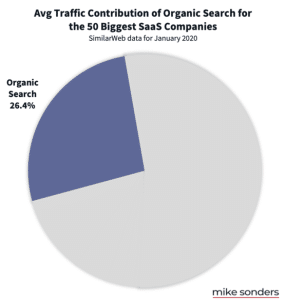
Even if you know this, a quick Google search for how to make your SaaS blog awesome will lead you to tons of articles with generic SEO recommendations like “focus on keywords” and “develop personas.”
While that advice may be accurate in a general sense, it doesn’t get down to the nitty gritty of what SaaS companies need specifically to create blogs that drive traffic and convert leads.
So we’re here to do it. What follows is our no-BS blogging strategy for SaaS products.
Quick Takeaways
- Great SaaS blogs have a personality that makes technical content approachable.
- Maintaining timely content is essential in the SaaS industry where products change often.
- Addressing customer pain points in SaaS blog content shows customers why your solution is relevant for them.
- Long-form content and unique opinion pieces can showcase your brand’s expertise.
- SaaS blogs should include content specific for each stage of the buyer journey.
The No-BS Blogging Strategy for SaaS Companies
We can’t emphasize enough how difficult — but also essential — differentiating your blog is in the SaaS world. It’s one of the fastest growing industries on the planet, and competition for business is fierce.
Now that everyone knows content marketing is a necessary component of every marketing strategy, it’s not enough anymore to just have a blog.
Instead, you need to have a blog that ranks high on Google, makes people want to click onto your site, engages them while they’re there, and ultimately converts them into paying customers.
NBD, right?
If we’re sticking with our no-BS policy (and we promise we will), we have to tell you that no, it isn’t no big deal, and it’s not always easy to create and maintain an effective blog. But if you do it right and start seeing results, you’ll have no shortage of motivation to keep going.
So let’s get to it, our first strategy for making your SaaS blog stand out:
Have a Personality
Even some of the most highly-trafficked SaaS blogs (think of some you know, we won’t name names) sometimes skip the personality when it comes to blog posts.
I guess if you’ve got millions of visitors every week you can gloss over the extras every now and then, but we don’t recommend it — especially not for newer SaaS blogs or companies trying to revamp their current strategies.
The truth is that SaaS products are extremely valuable to the companies who need and use them, but they’re not the most exciting products out there. In fact, they’re more the vehicles for getting the exciting stuff done.
Having a content marketing personality that stands out can make your readers feel excited about a product that otherwise could feel super technical or even flat-out boring. Let’s look at a few examples of SaaS blogs that do this well:
Groove, which sells customer service software for small businesses, manages to cover not-so-exciting topics in an engaging way. Knowledge bases? Kinda boring. Groove’s blog post about knowledge bases? Relatable. You only have to read the first few sentences before you’re thinking “Hey, me too!” and reading on.
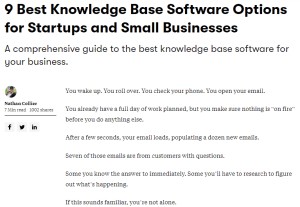
Neil isn’t afraid to talk about himself in his blogs, and with good reason. He’s one of the most prominent personalities in digital marketing SaaS, and he knows his stuff. But he’s also not afraid to crack a joke and manages to keep his blog relatable. His casual tone makes his blog feel like a friend or colleague showing you some cool new stuff rather than an “industry expert” telling you what to do.
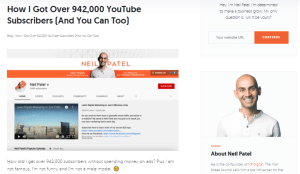
Close’s blogs reel you in from their snappy first sentences, where they tell it like it is and don’t shy away from getting snarky (I’m a firm supporter of the snark). Their ability to tell it like it is makes you feel willing to read about even the most onerous topic (like the one below about cold calling, where they start out by telling you they know — it’s damn hard work).
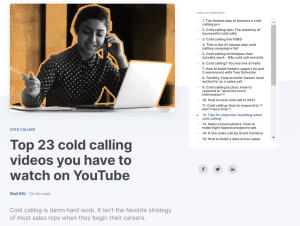
Keep Things Timely
Hear me out — I know I told you no BS, and I know this is one you’ll see on just about every “how to do a blog” blog out there. But it’s also really important for SaaS content for reasons beyond keeping your SEO rankings high (although yes, that’s important too).
SaaS products update and change more than almost any other type of product. New code is released weekly (or even more frequently) and major releases can happen several times per year.
Updating old posts to keep your sources recent and meet new SEO standards is important for every brand. But for SaaS companies, it’s the difference between your content being accurate or outdated. The worst thing would be for a potential customer to visit your blog only to find that your content isn’t relevant anymore.
To keep your blog up to date, do two things. First, look through your content when major product updates to make sure it reflects the most recent and accurate information. Second, look at your best-performing and worst-performing blog posts. Do you see trends? As you update old posts, emulate practices from your best-performing content to improve content that isn’t performing so well.
Address Pain Points
Companies and consumers seek out SaaS solutions to do something they can’t do themselves. What does that mean? They’re dealing with a problem or challenge — or pain point.
Creating pain point content engages potential customers by making them feel understood. It better demonstrates the value of your product by directly communicating how it can solve your customer’s problem.
It also makes people more likely to find you in the first place.
Think like your customer for a moment. If you’re going to Google to look for a SaaS solution, odds are you don’t yet know the companies who provide the solution you need. All you do know is your pain point. So, that’s what you search for.
Here’s a (very) simplified explanation of what we mean:
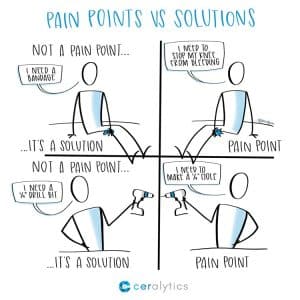
This is where many SaaS companies do it wrong. They focus too much on the features of the drill when all the customer knows is that they need to make a hole. Features and benefits are of course relevant to customers too.
However, if they can’t see why they’re relevant (through your connection to their pain point) or they don’t know how to search for them, you’re unlikely to gain much traction with your content.
This is why “how-to” guides are one of the best performing types of blog posts. They address a pain point, typically right in the title, and draw people in by telling them they’ll learn how to solve their problem. Once they’re there, you can show how your solution is the best choice for getting it done.
Show Your Expertise
Purchasing an SaaS solution can be a significant investment, and customers expect that the companies they choose to provide solutions will be experts on their products and industries. It is now oft-cited that B2B buyers complete 70% of their research independently before ever reaching out to a company directly.
If they’re not communicating with you, how are you supposed to show your expertise?
On your blog.
We already know that when potential customers arrive on your blog, you want them to feel engaged (by your personality) and understood (by your addressing their pain points). What you also want them to feel is confident in your ability to deliver the solution they need. Showing your expertise is one of the best ways to do it.
Here are some ways to show leverage your content to demonstrate expertise:
Produce Quality Long-Form Content
Long-form content allows you to get into the details (that nitty gritty we mentioned) of how products work and how customers can use them to get results. According to Neil Patel, long-form content earns more shares, traffic, and inbound links than shorter blog posts.
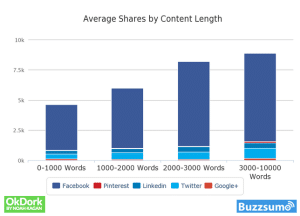
You can use long-form content to produce detailed product guides, how-to tutorials, industry research, and other educational topics important to your potential customers.
Have a Unique Opinion
Have you ever searched for a topic and found 10 articles that all say basically the same thing? Me too, and it’s annoying! You don’t always have to fall in line with the status quo opinion in your industry. Further, maintaining an autonomous opinion that’s unique and insightful can be what draws your customers in.
This doesn’t mean you have to be a contrarian. It just means you’re willing to have a fresh take on something and back it up with evidence.
Quick example from my own experience:
For a long time now, customer personas have been the “it” thing for marketers. I think personas can be really effective, but I was sick of seeing so-called experts throw the same persona strategies out there when they just weren’t effective.
So I put a fresh spin on it, and talked about why personas are great — except when they suck (this was actually the title of the blog post). It ended up being one of my best performing posts. Why? Because people appreciated the honesty along with a new way to leverage personas that actually worked.
The lesson: don’t shy away from putting a fresh spin on tired topics within the industry. As long as you’re genuine and able to support your opinion, it will be a winning tactic. Customers will appreciate the new perspective and you might even start some good conversation with industry peers.
Target Every Stage of the Funnel
Let’s go back to the stat we mentioned previously about B2B customers doing their own research — 70%, to be specific. It’s safe to say that if customers are doing 70% of their research independently, you’re getting visitors at every stage of the sales funnel (or buyer journey). This means you need to create content specific to every stage.
The takeaway: starting with educational content geared toward the awareness stage all the way through to case studies and sales-focused content targeting later stages of the funnel, it’s essential to create content that resonates with audiences at every stage of the buyer journey.
It’s important to note that retention is not only a stage of the buyer journey, but a really important one for SaaS companies. Given the nature of SaaS products and packages, there is ample opportunity to retain customers and upsell expanded packages or additional products and services.
You can design your blog to contain relevant information for current customers that continues to increase the value of your product for them well after they’ve made an initial purchase. Salesforce does this really well with their Trailhead program that offers classes, tutorials, and guides to help Salesforce users continually improve their skills and find new ways to use Salesforce products.
Launch Your Winning SaaS Blogging Strategy Now
Let’s put it all together. Your SaaS company needs a blog, but not just any blog. An awesome SaaS blog will:
- Have an engaging personality that makes technical content approachable and interesting
- Always stay up to date to reflect current product updates and releases
- Address customer pain points in ways that demonstrate why your solution is relevant
- Show your expertise through quality long-form content and unique opinions
- Include content that targets audiences at every stage of the buyer journey
If you’re ready to launch a strategy that includes all of these best practices but aren’t sure where to start, Marketing Insider Group can help. We have writers that can deliver blog posts for you every week for a whole year (or more) and our Content Builder Services include a full content audit and a detailed annual content plan.
Schedule a free consultation with me to learn more!






